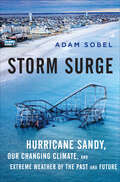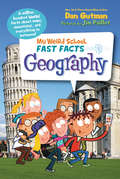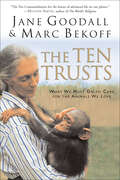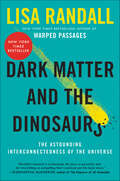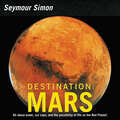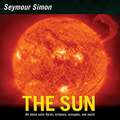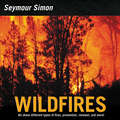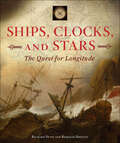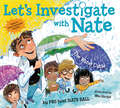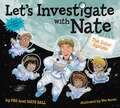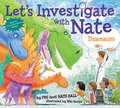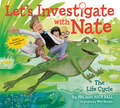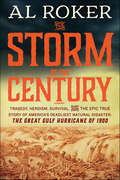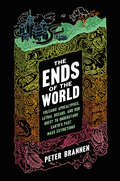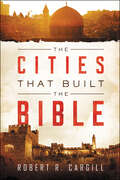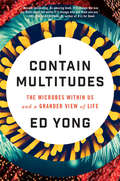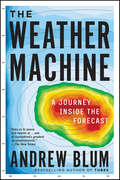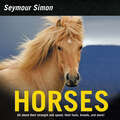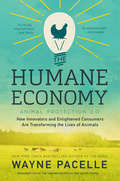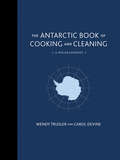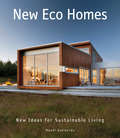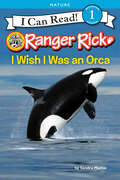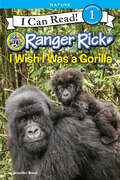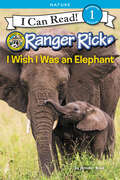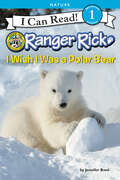- Table View
- List View
Storm Surge: Hurricane Sandy, Our Changing Climate, and Extreme Weather of the Past and Future
by Adam SobelWas Sandy a freak of nature, or the new normal?On October 29, 2012, Hurricane Sandy reached the shores of the northeastern United States to become one of the most destructive storms in history. But was Sandy a freak event, or should we have been better prepared for it? Was it a harbinger of things to come as the climate warms? In this fascinating and accessible work of popular science, atmospheric scientist and Columbia University professor Adam Sobel addresses these questions, combining his deep knowledge of the climate with his firsthand experience of the event itself.Sobel explains the remarkable atmospheric conditions that gave birth to Sandy and determined its path. He gives us insight into the science that led to the accurate forecasts of the storm from genesis to landfall, as well as an understanding of why our meteorological vocabulary failed our leaders in warning us about this unprecedented weather system—part hurricane, part winter-type nor'easter, fully deserving of the title "Superstorm."Storm Surge brings together the melting glaciers, the warming oceans, and a broad historical perspective to explain how our changing climate and developing coastlines are making New York and other cities more vulnerable. Engaging, informative, and timely, Sobel's book provokes us to think differently about how we can better prepare for the storms in our future.
My Weird School Fast Facts: Geography (My Weird School Fast Facts)
by Dan Gutman Jim PaillotThink fast with A.J. and Andrea from My Weird School!Did you know that Antarctica's largest land animal is an insect? Did you know that the smallest country in the world is only 0.2 square miles?!Learn more weird-but-true geography facts with A.J. and Andrea from Dan Gutman's bestselling My Weird School series. This all-new series of nonfiction books features hundreds of hysterical facts, plus lots of photos and illustrations.Whether you're a kid who wants to learn more about geography or simply someone who wants to know if there's really a town called Scratch Ankle, this geography facts edition is the book for you.With more than 9.5 million books sold, the My Weird School series really gets kids reading!
The Ten Trusts: What We Must Do to Care for The Animals We Love
by Marc Bekoff Jane GoodallWorld-renowned behavioral scientists Jane Goodall and Marc Bekoff have set forth ten trusts that we must honor as custodians of the planet. They argue passionately and persuasively that if we put these trusts to work in our lives, the earth and all its inhabitants will be able to live together harmoniously. The Ten Trusts expands the concept of our obligation to live in close relationship with animals -- for, of course, we humans are part of the animal kingdom -- challenging us to respect the interconnection between all living beings as we learn to care about and appreciate all species.The world is changing. We are gradually becoming more aware of the damage we are inflicting on the natural world. At this critical moment for the earth, Goodall and Bekoff share their hope and vision of a world where human cruelty and hatred are transformed into compassion and love for all living beings. They dream of a day when scientists and non-scientists can work together to transform the earth into a place where human beings live in peace and harmony with animals and the natural world.Simple yet profound, The Ten Trusts will not only change your perspective regarding how we live on this planet, it will establish your responsibilities as a steward of the natural world and show you how to live with respect for all life.
Dark Matter and the Dinosaurs: The Astounding Interconnectedness of the Universe
by Lisa Randall“Takes readers on illuminating scientific adventure, beginning sixty-six million years ago, that connects dinosaurs, comets, DNA, and the future of the planet.” —Huffington PostIn this brilliant exploration of our cosmic environment, the renowned particle physicist and New York Times–bestselling author of Warped Passages and Knocking on Heaven’s Door uses her research into dark matter to illuminate the startling connections between the furthest reaches of space and life here on Earth.Sixty-six million years ago, an object the size of a city descended from space to crash into Earth, creating a devastating cataclysm that killed off the dinosaurs, along with three-quarters of the other species on the planet. What was its origin? In Dark Matter and the Dinosaurs, Lisa Randall proposes it was a comet that was dislodged from its orbit as the Solar System passed through a disk of dark matter embedded in the Milky Way. In a sense, it might have been dark matter that killed the dinosaurs.Working through the background and consequences of this proposal, Randall shares with us the latest findings—established and speculative—regarding the nature and role of dark matter and the origin of the Universe, our galaxy, our Solar System, and life, along with the process by which scientists explore new concepts. In Dark Matter and the Dinosaurs, Randall tells a breathtaking story that weaves together the cosmos’ history and our own, illuminating the deep relationships that are critical to our world and the astonishing beauty inherent in the most familiar things.“Randall has woven a beautiful account of how life on Earth is intimately connected to the cosmos.” —The Daily Telegraph (UK)
Destination: Revised Edition
by Seymour SimonAward-winning science writer Seymour Simon explores the Red Planet through fascinating facts and amazing full-color photographs. Readers will learn about the recent discovery of water, the Valles Marineris—the biggest valley on Mars—the ice caps, recent expeditions, and more. This nonfiction picture book is an excellent choice to share during homeschooling, in particular for children ages 6 to 8. It’s a fun way to learn to read and as a supplement for activity books for children.This updated edition includes:author’s notestunning full-color photographsglossaryindexwebsites and additional reading sourcesSupports the Common Core Learning Standards, Next Generation Science Standards and the Science, Technology, Engineering, and Math (STEM) standards.
The Sun (Seymour Simon Science Ser.)
by Seymour SimonIn this completely updated edition of The Sun featuring beautiful full-color photographs, Seymour Simon presents a fascinating introduction to the star that is the center of our Solar System.Young readers will love exploring the wonders of the sun, from the constant nuclear explosions at its core to the sea of boiling gases that forms its surface.Seymour Simon knows how to explain science to kids and make it fun. He was a teacher for more than twenty years, has written more than 250 books, and has won multiple awards.This book includes an author's note, glossary, and index and supports the Common Core Learning Standards, Next Generation Science Standards, and the Science, Technology, Engineering, and Math (STEM) standards.
Wildfires
by Seymour SimonA raging wildfire can be a major disaster, costing lives and destroying homes. But fires in nature can help as well as harm, clearing forests of dead trees and allowing young plants to grow. Breathtaking photos highlight this surprising look at fire’s part in maintaining the balance of nature. This nonfiction picture book is an excellent choice to share during homeschooling, in particular for children ages 6 to 8. It’s a fun way to learn to read and as a supplement for activity books for children.This updated edition includes:• Author’s note• Stunning full-color photographs• Glossary• Index• Websites and additional reading sources• Series thumbnails on back coverSupports the Common Core Learning Standards, Next Generation Science Standards, and the Science, Technology, Engineering, and Math (STEM) standards
Ships, Clocks, and Stars: The Quest for Longitude
by Richard Dunn Rebekah HiggittAn illustrated history of an eighteenth-centuury British act of parliament and the heated race to find a ship’s precise longitude at sea.A tale of eighteenth-century invention and competition, commerce and conflict, this is a lively, illustrated, and accurate chronicle of the search to solve “the longitude problem,” the question of how to determine a ship’s position at sea—and one that changed the history of mankind.Ships, Clocks, and Stars brings into focus one of our greatest scientific stories: the search to accurately measure a ship’s position at sea. The incredible, illustrated volume reveals why longitude mattered to seafaring nations, illuminates the various solutions that were proposed and tested, and explores the invention that revolutionized human history and the man behind it, John Harrison. Here, too, are the voyages of Captain Cook that put these revolutionary navigational methods to the test.Filled with astronomers, inventors, politicians, seamen, and satirists, Ships, Clocks, and Stars explores the scientific, political, and commercial battles of the age, as well as the sailors, ships, and voyages that made it legend—from Matthew Flinders and George Vancouver to the voyages of the Bounty and the Beagle.Featuring more than 150 photographs specially commissioned from Britain’s National Maritime Museum, this evocative, detailed, and thoroughly fascinating history brings this age of exploration and enlightenment vividly to life.
Let's Investigate with Nate #1: The Water Cycle (Let's Investigate with Nate #1)
by Nate BallBill Nye the Science Guy meets The Magic School Bus!This is the first book in a new STEM-based picture book series from the Emmy Award-winning host of PBS’s Design Squad and Design Squad Nation, Nate Ball. With a lively cast of characters and vibrant illustrations by Wes Hargis, it's an adventure in learning! This nonfiction picture book is an excellent choice to share during homeschooling, in particular for children ages 4 to 6. It’s a fun way to learn to read and as a supplement for activity books for children.Ever wonder where water comes from and where it goes? Or why sometimes it rains and sometimes it snows? Then join Nate Ball and his crack team of curious scientists as they shrink down smaller than a raindrop to see firsthand what the water cycle is all about.
Let's Investigate with Nate #2: The Solar System (Let's Investigate with Nate #2)
by Nate BallBill Nye the Science Guy meets The Magic School Bus!This is the second book in a new STEM-based picture book series from the Emmy Award-winning host of PBS’s Design Squad and Design Squad Nation, Nate Ball. With a lively cast of characters and vibrant illustrations by Wes Hargis, it's an adventure in learning!Ever look up at the sky and wonder how many planets there are? Or want to know how many Earths could fit within the Sun? Take a ride 3.6 billion miles away to answer these questions and more while exploring the solar system with Nate and his team of adventurous scientists! Walk on the moon, fly with a satellite, gaze at comets, and discover why Pluto isn’t a planet anymore.
Let's Investigate with Nate #3: Dinosaurs (Let's Investigate with Nate #3)
by Nate BallBill Nye the Science Guy meets the Magic School Bus in this new STEM-based picture book series from the Emmy Award-winning host of PBS’s Design Squad and Design Squad Nation, Nate Ball. This nonfiction picture book is an excellent choice to share during homeschooling, in particular for children ages 4 to 6. It’s a fun way to learn to read and as a supplement for activity books for children.Ever head to the museum and wish you could go back in time to see how big dinosaurs really were? Or think about what dinosaurs ate and where they lived? Follow Nate and his diverse team of intrepid scientists as they travel back across the millennia to dig up prehistoric fossils, travel across ancient landscapes, and discover what caused the dinosaur’s mass extinction. Featuring vibrant illustrations by Wes Hargis and a lively and a lovable cast of characters, the Let’s Investigate with Nate books align to grade-appropriate state-level learning standards and curriculum.With sidebars and charts and graphs and interactive elements—including a Do It Yourself experiment at the back of the book—Dinosaurs takes young readers on an adventure in learning and makes learning an adventure!
Let's Investigate with Nate #4: The Life Cycle (Let's Investigate with Nate #4)
by Nate BallBill Nye the Science Guy meets the Magic School Bus in this new STEM-based picture book series from the Emmy Award-winning host of PBS’s Design Squad and Design Squad Nation, Nate Ball. This nonfiction picture book is an excellent choice to share during homeschooling, in particular for children ages 4 to 6. It’s a fun way to learn to read and as a supplement for activity books for children.Ever stop to smell the roses and wonder how they got there? Ever think about how tadpoles become frogs and how caterpillars become butterflies? Or want to know how they’re all connected?Follow Nate and his team of plucky scientists as they morph into tiny seeds, slippery tadpoles, and fuzzy caterpillars to learn about the life cycle. While on this adventure, learn all about how plants make food from the sun, why some animals transform as they mature, and what truly defines a living thing in this brand-new adventure from everyone’s favorite fun-loving scientist and Emmy Award–winning PBS star, Nate Ball.Featuring vibrant illustrations by Wes Hargis and a lively and a lovable cast of characters, the Let’s Investigate with Nate books align to grade-appropriate state-level learning standards and curriculum. With sidebars and charts and graphs and interactive elements—including a Do It Yourself experiment at the back of the book—The Life Cycle takes young readers on an adventure in learning and makes learning an adventure!
The Storm of the Century: Tragedy, Heroism, Survival, and the Epic True Story of America's Deadliest Natural Disaster
by Al RokerIn this gripping narrative history, Al Roker from NBC’s Today and the Weather Channel vividly examines the deadliest natural disaster in American history—a haunting and inspiring tale of tragedy, heroism, and resilience that is full of lessons for today’s new age of extreme weather.On the afternoon of September 8, 1900, two-hundred-mile-per-hour winds and fifteen-foot waves slammed into Galveston, the booming port city on Texas’s Gulf Coast. By dawn the next day, the city that hours earlier had stood as a symbol of America’s growth and expansion was now gone. Shattered, grief-stricken survivors emerged to witness a level of destruction never before seen: Eight thousand corpses littered the streets and were buried under the massive wreckage. Rushing water had lifted buildings from their foundations, smashing them into pieces, while wind gusts had upended steel girders and trestles, driving them through house walls and into sidewalks. No race or class was spared its wrath. In less than twenty-four hours, a single storm had destroyed a major American metropolis—and awakened a nation to the terrifying power of nature.Blending an unforgettable cast of characters, accessible weather science, and deep historical research into a sweeping and dramatic narrative, The Storm of the Century brings this legendary hurricane and its aftermath into fresh focus. No other natural disaster has ever matched the havoc caused by the awesome mix of winds, rain, and flooding that devastated Galveston and shocked a young, optimistic nation on the cusp of modernity. Exploring the impact of the tragedy on a rising country’s confidence—the trauma of the loss and the determination of the response—Al Roker illuminates the United States’s character at the dawn of the “American Century,” while also underlining the fact that no matter how mighty they may become, all nations must respect the ferocious potential of our natural environment.
The Ends of the World: Volcanic Apocalypses, Lethal Oceans, and Our Quest to Understand Earth's Past Mass Extinctions
by Peter BrannenAs new groundbreaking research suggests that climate change played a major role in the most extreme catastrophes in the planet's history, award-winning science journalist Peter Brannen takes us on a wild ride through the planet's five mass extinctions and, in the process, offers us a glimpse of our increasingly dangerous future Our world has ended five times: it has been broiled, frozen, poison-gassed, smothered, and pelted by asteroids. In The Ends of the World, Peter Brannen dives into deep time, exploring Earth’s past dead ends, and in the process, offers us a glimpse of our possible future.Many scientists now believe that the climate shifts of the twenty-first century have analogs in these five extinctions. Using the visible clues these devastations have left behind in the fossil record, The Ends of the World takes us inside “scenes of the crime,” from South Africa to the New York Palisades, to tell the story of each extinction. Brannen examines the fossil record—which is rife with creatures like dragonflies the size of sea gulls and guillotine-mouthed fish—and introduces us to the researchers on the front lines who, using the forensic tools of modern science, are piecing together what really happened at the crime scenes of the Earth’s biggest whodunits.Part road trip, part history, and part cautionary tale, The Ends of the World takes us on a tour of the ways that our planet has clawed itself back from the grave, and casts our future in a completely new light.
The Cities That Built the Bible
by Robert R. Cargill“An expert guide and teacher . . . delves into difficult topics with humor and ease. . . . Well worth reading.” —Biblical ArcheologyFor many, the names Bethlehem, Babylon, and Jerusalem are known as the setting for epic stories from the Bible. What often gets missed is that these cities are far more than just the setting for the Bible and its characters—they were instrumental to the creation of the Bible as we know it today.Robert Cargill, archeologist, Bible scholar, and host of the History Channel series Bible Secrets Revealed, blends archaeology, biblical history, and personal journey as he explores ancient cities and their role in the creation of the Bible. He reveals surprising facts such as what the Bible says about the birth of Jesus and how Mary’s Virgin Birth caused problems for the early church. We’ll also see how the God of the Old Testament was influenced by other deities, and how far more books were left out of the Bible than were let in during the canonization process.The Cities That Built the Bible is a magnificent tour through fourteen cities: the Phoenicia cities of Tyre, Sidon, and Byblos, Ugarit, Nineveh, Babylon, Megiddo, Athens, Alexandria, Jerusalem, Qumran, Bethlehem, Nazareth, and Rome. Along the way, Cargill includes photos of artifacts, dig sites, ruins, and relics in this fascinating exploration that sheds new light on the Bible.“A lively personal account that puts flesh and bones on the tale.” —Richard Elliott Friedman, Th.D. author of The Bible with Sources Revealed“Cargill transports readers to these ancient locales, illuminating the municipal dynamics that shaped the Bible.” —Booklist
I Contain Multitudes: The Microbes Within Us and a Grander View of Life
by Ed YongNew York Times BestsellerNew York Times Notable Book of 2016 • NPR Great Read of 2016 • Named a Best Book of 2016 by The Economist, Smithsonian, NPR's Science Friday, MPR, Minnesota Star Tribune, Kirkus Reviews, Publishers Weekly, The Guardian, Times (London)From Pulitzer Prize winner Ed Yong, a groundbreaking, wondrously informative, and vastly entertaining examination of the most significant revolution in biology since Darwin—a “microbe’s-eye view” of the world that reveals a marvelous, radically reconceived picture of life on earth.Every animal, whether human, squid, or wasp, is home to millions of bacteria and other microbes. Pulitzer Prize-winning author Ed Yong, whose humor is as evident as his erudition, prompts us to look at ourselves and our animal companions in a new light—less as individuals and more as the interconnected, interdependent multitudes we assuredly are.The microbes in our bodies are part of our immune systems and protect us from disease. In the deep oceans, mysterious creatures without mouths or guts depend on microbes for all their energy. Bacteria provide squid with invisibility cloaks, help beetles to bring down forests, and allow worms to cause diseases that afflict millions of people.Many people think of microbes as germs to be eradicated, but those that live with us—the microbiome—build our bodies, protect our health, shape our identities, and grant us incredible abilities. In this astonishing book, Ed Yong takes us on a grand tour through our microbial partners, and introduces us to the scientists on the front lines of discovery. It will change both our view of nature and our sense of where we belong in it.
The Weather Machine: A Journey Inside the Forecast
by Andrew BlumFrom the acclaimed author of Tubes, a lively and surprising tour of the infrastructure behind the weather forecast, the people who built it, and what it reveals about our climate and our planetThe weather is the foundation of our daily lives. It’s a staple of small talk, the app on our smartphones, and often the first thing we check each morning. Yet behind these quotidian interactions is one of the most expansive machines human beings have ever constructed—a triumph of science, technology and global cooperation. But what is this ‘weather machine’ and who created it? In The Weather Machine, Andrew Blum takes readers on a fascinating journey through an everyday miracle. In a quest to understand how the forecast works, he visits old weather stations and watches new satellites blast off. He follows the dogged efforts of scientists to create a supercomputer model of the atmosphere and traces the surprising history of the algorithms that power their work. He discovers that we have quietly entered a golden age of meteorology—our tools allow us to predict weather more accurately than ever, and yet we haven’t learned to trust them, nor can we guarantee the fragile international alliances that allow our modern weather machine to exist.Written with the sharp wit and infectious curiosity Andrew Blum is known for, The Weather Machine pulls back the curtain on a universal part of our everyday lives, illuminating our relationships with technology, the planet, and the global community.
Horses: Revised Edition
by Seymour SimonFrom award-winning science writer Seymour Simon comes a completely revised and updated edition of Horses, with brand-new full-color photographs. This nonfiction picture book is an excellent choice to share during homeschooling, in particular for children ages 6 to 8. It’s a fun way to learn to read and as a supplement for activity books for children.Readers will learn how horses came to be domesticated, how to distinguish different breeds, the important roles horses have served throughout history, and more. From stallions and mares and Clydesdales to Palominos, this is sure to be a hit with horse lovers and animal lovers everywhere!This updated edition includes:• author’s note• stunning full-color photographs• glossary• index• additional reading sourcesSupports the Common Core Learning Standards, Next Generation Science Standards and the Science, Technology, Engineering, and Math (STEM) standards.
The Humane Economy: How Innovators and Enlightened Consumers Are Transforming the Lives of Animals
by Wayne PacelleA major new exploration of the economics of animal exploitation and a practical roadmap for how we can use the marketplace to promote the welfare of all living creatures, from the renowned animal-rights advocate Wayne Pacelle, President/CEO of the Humane Society of the United States and New York Times bestselling author of The Bond.In the mid-nineteenth century, New Bedford, Massachusetts was the whaling capital of the world. A half-gallon of sperm oil cost approximately $1,400 in today's dollars, and whale populations were hunted to near extinction for profit. But with the advent of fossil fuels, the whaling industry collapsed, and today, the area around New Bedford is instead known as one of the best places in the world for whale watching.This transformation is emblematic of a new sort of economic revolution, one that has the power to transform the future of animal welfare. In The Humane Economy, Wayne Pacelle, President/CEO of the Humane Society of the United States, explores how our everyday economic decisions impact the survival and wellbeing of animals, and how we can make choices that better support them. Though most of us have never harpooned a sea creature, clubbed a seal, or killed an animal for profit, we are all part of an interconnected web that has a tremendous impact on animal welfare, and the decisions we make--whether supporting local, not industrial, farming; adopting a rescue dog or a shelter animal instead of one from a "puppy mill"; avoiding products that compromise the habitat of wild species; or even seeing Cirque du Soleil instead of Ringling Brothers--do matter. The Humane Economy shows us how what we do everyday as consumers can benefit animals, the environment, and human society, and why these decisions can make economic sense as well.
The Antarctic Book of Cooking and Cleaning: A Polar Journey
by Carol Devine Wendy TruslerThis stunning chronicle of the first civilian Antarctic clean-up project, with contemporary and historic anecdotes and photographs, journal entries, and more than forty delicious recipes, is an intricately woven ode to the last wilderness.With more than 130 full-color photographs
New Eco Homes
by Manel GutierrezDiscover the latest in eco-friendly home architecture and design.New Eco Homes features twenty-two sustainable homes from around the globe that showcase the newest innovations in environmentally minded home design.<P><P> Inside you'll find the latest design strategies such as various ways to use natural light and ventilation to reduce energy consumption, new methods to integrate home construction into the surrounding landscape, and the numerous recycled and green construction materials that are available today. Specific topics covered include climate regulation, drainage systems, and regional planning. Accompanying each project is a series of colorful photographs, floor plans, and detailed drawings that illustrate sustainable features.This book demonstrates the wide array of ecological and environmental construction solutions that are being applied around the world as a reflection of the growing concern for the environment and energy savings in home building. Whether you're an architect, a designer, or a homeowner looking for new ways to update your home to make it more eco-friendly, this inspiring book is the perfect resource for creating a welcoming and sustainable home.
Ranger Rick: I Wish I Was an Orca (I Can Read Level 1)
by Sandra MarkleDive into the lives of orcas with Ranger Rick in this beginning reader with full-color photos of orcas in the wild! What if you wished you were an orca? And then you became one? An orca is an amazing kind of whale. Could you eat like an orca? Sleep like an orca? Live in an orca family? And would you want to? Find out! Ranger Rick explorers can learn all about orcas in this reader full of fascinating facts, vivid wildlife photographs, a Wild Words glossary, and a hands-on activity about how to communicate like an orca!Ranger Rick: I Wish I Was an Orca is a Level One I Can Read, which means it’s perfect for children learning to sound out words and sentences. Whether shared at home or in a classroom, the short sentences, familiar words, and simple concepts of Level One books support success for children eager to start reading on their own.
Ranger Rick: I Wish I Was a Gorilla (I Can Read Level 1)
by Jennifer BovéExplore the lives of gorillas with Ranger Rick in this beginning reader with full-color photos of gorillas in the wild! What if you wished you were a gorilla and then you became one? Could you eat like a gorilla? Sleep like a gorilla? Live in a gorilla family? And would you want to? Find out!Ranger Rick explorers can learn all about gorillas in this reader full of fascinating facts, vivid wildlife photographs, a Wild Words glossary, and a hands-on activity about how to make a snack like a gorilla! Ranger Rick: I Wish I Was a Gorilla is a Level One I Can Read, which means it’s perfect for children learning to sound out words and sentences. Whether shared at home or in a classroom, the short sentences, familiar words, and simple concepts of Level One books support success for children eager to start reading on their own.
Ranger Rick: I Wish I Was an Elephant (I Can Read Level 1)
by Jennifer BovéExplore the lives of elephants with Ranger Rick in this beginning reader with full-color photos of elephants in the wild!What if you wished you were an elephant and then you became one? Could you talk like an elephant? Sleep like an elephant? Live in an elephant family? And would you want to? Find out! Ranger Rick explorers can learn all about elephants in this reader full of fascinating facts, vivid wildlife photographs, a Wild Words glossary, and a hands-on activity about how to play “elephant hockey” using your arm like an elephant trunk. Ranger Rick: I Wish I Was an Elephant is a Level One I Can Read, which means it’s perfect for children learning to sound out words and sentences. Whether shared at home or in a classroom, the short sentences, familiar words, and simple concepts of Level One books support success for children eager to start reading on their own.
Ranger Rick: I Wish I Was a Polar Bear (I Can Read Level 1)
by Jennifer BovéExplore the lives of polar bears with Ranger Rick in this beginning reader with full-color photos of polar bears in the wild! What if you wished you were a polar bear and then you became one? Could you eat like a polar bear? Talk like a polar bear? Live in the cold Arctic tundra? And would you want to? Find out!Ranger Rick explorers can learn all about polar bears in this reader full of fascinating facts, vivid wildlife photographs, a Wild Words glossary, and a paws-on activity that shows readers how blubber works using ice water and vegetable shortening! Ranger Rick, the iconic raccoon ambassador from Ranger Rick magazine, asks questions like: Would you want to nap on the snow? Brrr!Ranger Rick: I Wish I Was a Polar Bear is a Level One I Can Read book, which means it’s perfect for children learning to sound out words and sentences. Whether shared at home or in a classroom, the short sentences, familiar words, and simple concepts of Level One books support success for children eager to start reading on their own.
